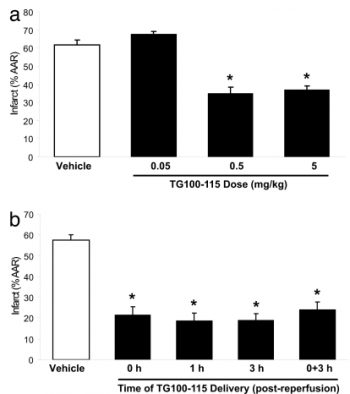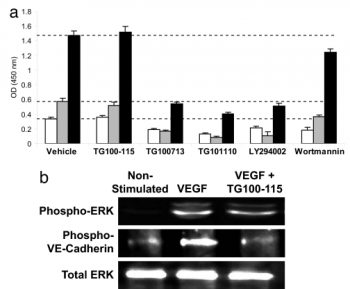
| Size | Price | Stock | Qty |
|---|---|---|---|
| 5mg |
|
||
| 10mg |
|
||
| 25mg |
|
||
| 50mg |
|
||
| 100mg |
|
||
| 250mg |
|
||
| 500mg |
|
||
| Other Sizes |
|
Purity: ≥98%
TG100-115 is a novel, potent and selective PI3Kγ/δ inhibitor with potential cardioprotecting effects. With an IC50 of 83 nM and 235 nM, respectively, it barely affects PI3Kγ/δ and inhibits PI3Kα/β.
| Targets |
PI3Kγ (IC50 = 83 nM); PI3Kδ (IC50 = 235 nM); PI3Kβ (IC50 = 1.2 μM)
|
|---|---|
| ln Vitro |
TG100-115 inhibits PI3Kγ and -δ, with IC50 of 83 and 235 nM, respectively. TG100-115 is not active for PI3Kα and -β, with IC50 of 1.2 and 1.3 mM. TG100-115 (up to 10 M) has no impact on VEGF-stimulated ERK phosphorylation or cell proliferation in human umbilical vein endothelial cells (HUVECs). The VEGF signaling pathways that result in VE-cadherin phosphorylation are among those that are disrupted by TG100-115 (10 M). [1] The VEGF-induced rise in the overall level of VE-cadherin in HUVECs is inhibited by TG100-115 (10 M). mTOR and p70S6 kinase, which are both downstream of PI3K, are both phosphorylated by VEGF and are inhibited by TG100-115. The phosphorylation of Akt induced by FGF is also inhibited by TG100-115 (125 nM to 10 M). [2]
|
| ln Vivo |
TG100-115 (1–5 mg/kg) lessens edema formation and inflammation in rats in Miles assay models. TG100-115 (0.5-5 mg/kg) offers powerful cardioprotection in rigorous rodent and porcine models of myocardial ischemia (MI), restricts the growth of infarcts, and maintains myocardial function. [1] The fact that TG100-115 (5 mg/kg) significantly reduces vascular permeability (VP) in mice in response to Sema3A or VEGF suggests that both substances may rely on PI3Kγ/δ for VP induction. [3] Aerosolized TG100-115 significantly lowers pulmonary eosinophilia in a mouse asthma model and inhibits interleukin-13 and mucin accumulation. [4]
|
| Enzyme Assay |
To achieve linear kinetics over 90 minutes, 40 mL of reaction buffer (20 mM Tris/4 mM MgCl2/10 mM NaCl, pH 7.4) containing 50 mM D-myo-phosphatidylinositol 4,5-bisphosphate substrate and the desired PI3K isoform is aliquoted to 96-well plates. Then, 2.5 mL of a DMSO stock containing TG100-115 is added, bringing the final concentration range of 100 mM to 1 nM. The Ultra 384 instrument is used to measure luminosity. Reactions are started by adding 10 mL of ATP to a final concentration of 3 mM. After 90 minutes, 50 mL of Kinase-Glo reagent is added to quantify residual ATP levels. Additionally, control reactions without either the substrate or TG100-115 are carried out.
|
| Cell Assay |
In assay medium containing 0.5% serum and 50 ng/ml VEGF, cells plated in 96-well cluster plates (5 103 cells/well) are cultured in the presence or absence of TG100-115. Cell numbers are then quantified by XTT assay 24–48–72 hours later.
|
| Animal Protocol |
Rat: TG100-115 (1 mg/kg) or vehicle is injected intravenously into Sprague-Dawley rats (175-200 g), and 1-4 hours later, 500 μl of a 2% sterile saline solution containing Evans blue dye is injected. Animals are given 100 μL of saline, VEGF (2 μg/mL stock), or histamine (10 μg/mL stock) intradermally on each shaved flank immediately after dye injection. Injection sites are photographed 30 minutes after administration.
|
| References | |
| Additional Infomation |
3-[2,4-diamino-7-(3-hydroxyphenyl)-6-pteridinyl]phenol is a member of pteridines.
An NSAID that inhibits PI-3K gamma and delta. Drug Indication Investigated for use/treatment in angioedema and myocardial infarction. |
| Molecular Formula |
C18H14N6O2
|
|---|---|
| Molecular Weight |
346.3428
|
| Exact Mass |
346.117
|
| Elemental Analysis |
C, 62.42; H, 4.07; N, 24.27; O, 9.24
|
| CAS # |
677297-51-7
|
| Related CAS # |
677297-51-7
|
| PubChem CID |
10427712
|
| Appearance |
Light yellow to yellow solid powder
|
| Density |
1.5±0.1 g/cm3
|
| Boiling Point |
699.6±65.0 °C at 760 mmHg
|
| Flash Point |
376.9±34.3 °C
|
| Vapour Pressure |
0.0±2.3 mmHg at 25°C
|
| Index of Refraction |
1.803
|
| LogP |
0.99
|
| Hydrogen Bond Donor Count |
4
|
| Hydrogen Bond Acceptor Count |
8
|
| Rotatable Bond Count |
2
|
| Heavy Atom Count |
26
|
| Complexity |
483
|
| Defined Atom Stereocenter Count |
0
|
| SMILES |
O([H])C1=C([H])C([H])=C([H])C(=C1[H])C1C(C2C([H])=C([H])C([H])=C(C=2[H])O[H])=NC2C(=C(N([H])[H])N=C(N([H])[H])N=2)N=1
|
| InChi Key |
UJIAQDJKSXQLIT-UHFFFAOYSA-N
|
| InChi Code |
InChI=1S/C18H14N6O2/c19-16-15-17(24-18(20)23-16)22-14(10-4-2-6-12(26)8-10)13(21-15)9-3-1-5-11(25)7-9/h1-8,25-26H,(H4,19,20,22,23,24)
|
| Chemical Name |
3-[2,4-diamino-6-(3-hydroxyphenyl)pteridin-7-yl]phenol
|
| Synonyms |
TG100115; TG-100115; TG 100115; TG-100-115; TG100-115 ; TG 100-115
|
| HS Tariff Code |
2934.99.9001
|
| Storage |
Powder -20°C 3 years 4°C 2 years In solvent -80°C 6 months -20°C 1 month |
| Shipping Condition |
Room temperature (This product is stable at ambient temperature for a few days during ordinary shipping and time spent in Customs)
|
| Solubility (In Vitro) |
DMSO: ~9 mg/mL (~26 mM)
Water: <1 mg/mL Ethanol: <1 mg/mL |
|---|---|
| Solubility (In Vivo) |
Solubility in Formulation 1: 2.5 mg/mL (7.22 mM) in 10% DMSO + 40% PEG300 + 5% Tween80 + 45% Saline (add these co-solvents sequentially from left to right, and one by one), clear solution; with sonication.
For example, if 1 mL of working solution is to be prepared, you can add 100 μL of 25.0 mg/mL clear DMSO stock solution to 400 μL PEG300 and mix evenly; then add 50 μL Tween-80 to the above solution and mix evenly; then add 450 μL normal saline to adjust the volume to 1 mL. Preparation of saline: Dissolve 0.9 g of sodium chloride in 100 mL ddH₂ O to obtain a clear solution. Solubility in Formulation 2: 2.5 mg/mL (7.22 mM) in 10% DMSO + 90% (20% SBE-β-CD in Saline) (add these co-solvents sequentially from left to right, and one by one), clear solution; with ultrasonication. For example, if 1 mL of working solution is to be prepared, you can add 100 μL of 25.0 mg/mL clear DMSO stock solution to 900 μL of 20% SBE-β-CD physiological saline solution and mix evenly. Preparation of 20% SBE-β-CD in Saline (4°C,1 week): Dissolve 2 g SBE-β-CD in 10 mL saline to obtain a clear solution. View More
Solubility in Formulation 3: 5%DMSO+30%PEG 300+ddH2O: 0.4mg/mL |
| Preparing Stock Solutions | 1 mg | 5 mg | 10 mg | |
| 1 mM | 2.8873 mL | 14.4367 mL | 28.8734 mL | |
| 5 mM | 0.5775 mL | 2.8873 mL | 5.7747 mL | |
| 10 mM | 0.2887 mL | 1.4437 mL | 2.8873 mL |
*Note: Please select an appropriate solvent for the preparation of stock solution based on your experiment needs. For most products, DMSO can be used for preparing stock solutions (e.g. 5 mM, 10 mM, or 20 mM concentration); some products with high aqueous solubility may be dissolved in water directly. Solubility information is available at the above Solubility Data section. Once the stock solution is prepared, aliquot it to routine usage volumes and store at -20°C or -80°C. Avoid repeated freeze and thaw cycles.
Calculation results
Working concentration: mg/mL;
Method for preparing DMSO stock solution: mg drug pre-dissolved in μL DMSO (stock solution concentration mg/mL). Please contact us first if the concentration exceeds the DMSO solubility of the batch of drug.
Method for preparing in vivo formulation::Take μL DMSO stock solution, next add μL PEG300, mix and clarify, next addμL Tween 80, mix and clarify, next add μL ddH2O,mix and clarify.
(1) Please be sure that the solution is clear before the addition of next solvent. Dissolution methods like vortex, ultrasound or warming and heat may be used to aid dissolving.
(2) Be sure to add the solvent(s) in order.
| NCT Number | Status | Interventions | Conditions | Sponsor/Collaborators | Start Date | Phases |
| NCT00103350 | Completed | Drug: TG100-115 | Myocardial Infarction | TargeGen | January 2005 | Phase 1 Phase 2 |
|
 |
 |